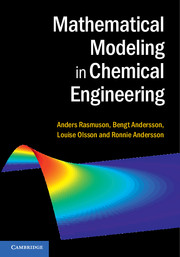Book contents
- Frontmatter
- Contents
- Preface
- 1 Introduction
- 2 Classification
- 3 Model formulation
- 4 Empirical model building
- 5 Strategies for simplifying mathematical models
- 6 Numerical methods
- 7 Statistical analysis of mathematical models
- Appendix A Microscopic transport equations
- Appendix B Dimensionless variables
- Appendix C Student’s t-distribution
- Bibliography
- Index
6 - Numerical methods
Published online by Cambridge University Press: 05 June 2014
- Frontmatter
- Contents
- Preface
- 1 Introduction
- 2 Classification
- 3 Model formulation
- 4 Empirical model building
- 5 Strategies for simplifying mathematical models
- 6 Numerical methods
- 7 Statistical analysis of mathematical models
- Appendix A Microscopic transport equations
- Appendix B Dimensionless variables
- Appendix C Student’s t-distribution
- Bibliography
- Index
Summary
Differential equations play a dominant role in mathematical modeling. In practical engineering applications, only a very limited number of them can be solved analytically. The purpose of this chapter is to give an introduction to the numerical methods needed to solve differential equations, and to explain how solution accuracy can be controlled and how stability can be ensured by selecting the appropriate methods. The mathematical framework needed to solve both ordinary and partial differential equations is presented. A guideline for selecting numerical methods is presented at the end of the chapter.
Ordinary differential equations
A characteristic of a differential equation is that it involves an unknown function and one or more of the function’s derivatives. If the unknown function depends on only one independent variable, it is classified as an ordinary differential equation (ODE). The order of the differential equation is simply the order of the highest derivative that appears in the equations. Consequently, a first-order ODE contains only first derivatives, whilst a second-order ODE may contain both second and first derivatives. The ODEs can also be classified as linear or non-linear. Linear ODEs are the ones in which all dependent variables and their derivatives appear in a linear form. This implies that they cannot be multiplied or divided by each other, and they must be raised to the power of 1. An ODE has an infinite number of solutions, but with the appropriate conditions that describe systems, i.e. the initial value or the boundary value, the solutions can be determined uniquely.
Information
- Type
- Chapter
- Information
- Mathematical Modeling in Chemical Engineering , pp. 81 - 120Publisher: Cambridge University PressPrint publication year: 2014
